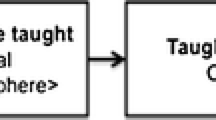Abstract
The reconstruction of pupils modelling processes can be found in many empirical studies within the literature on modelling. The empirical differentiations of the phases, which includes putting statements and actions of the pupils in the right phase, has not been reconstructed from a cognitive psychological point of view on a micro level thus far: In this article different modelling cycles are discussed with attention to distinctions in the various phases. The «modelling cycle under cognitive psychological aspects» is specifically emphasized in contrast to the other cycles. On the basis of the results of the COM2-project (Cognitive psychological analysis of modelling processes in mathematics lessons, Borromeo Ferri) the phases of the modelling processare described empirically. Some difficulties in the process of distinguishing the various phases are also pointed out.
Kurzreferat
Die Rekonstruktion von Modellierungsprozessen bei Lernenden ist in vielen empirischen Studien innerhalb der Literatur zum Modellieren zu finden. Die empirische Unterscheidung der Phasen, was die Einordnung von Aussagen und Handlungen der Lernenden miteinbezieht, wurde bisher noch nicht aus kognitionspsychologischer Sicht auf einer Mikroebene rekonstruiert. In diesem Artikel wird nach einer Übersicht ausgewählter Modellierungskreisläufe der «Modellierungskreislauf unter kognitionspsychologischen Aspekten im Vergleich hervorgehoben. Somit liegt der Fokus auf einer kognitionspsychologischen Perspektive hinsichtlich des Modellierungskreislaufes. Auf der Basis von Ergebnissen des KOM2-Projekt (Kognitionspsychologische Analysen von Modellierungsprozessen im Mathematikunterricht, Borromeo Ferri) werden die Phasen empirisch beschrieben und auch Schwierigkeiten bei der Einordnung in diese Phasen verdeutlicht.
Similar content being viewed by others
References
Anderson, J.R. (1976).Language, memory; and thought. Hillsdale, NJ: Erlbaum.
Blum, W. & Niss, M. (1991). Applied Mathematical Problem Solving. Modelling. Applications and Links to other Subjects—State, Trends and Issues in Mathematics Instruction. InEducational Studies in Mathematics, 22, No. 1, 37~68.
Blum, W. (1996). Anwendungsbezüge im Mathematik-unterricht—Trends und Perspektiven. In Kadunz, G. et al. (Eds.),Trends und Perspektiven. Schriftenreihe Didaktik der Mathematik, Vol. 23., Wien: Hölder-Pichler-Tempsky, 15–38.
Blum, W. & Leiss, D. (2005).“Filling Up”—the problem of independence-preserving teacher interventions in lessons with demanding modelling tasks. Paper for the CERME4 2005. WG 13 Modelling and Applications.
Blum, W. & Leiss D. (in press). How do students and teachers deal with mathematical modelling problems? The example “Filling up”. In Haines et al. (Eds.),Mathematical Modelling (ICTMA 12): Education, Engineering and Economics. Chichester: Horwood Publishing.
Borromeo Ferri, R. (2004a).Mathematische Denkstile. Ergebnisse einer empirischen Studie. Hildesheim: Franzbecker.
Borromeo Ferri, R. (2004b). Mathematical Thinking Styles and Word Problems. In Henn, Hans-Wolfgang & Blum, Werner (Eds.),Pre-Conference Proceedings of the ICMI Study 14, Applications and Modelling in Mathematics Education (pp. 47~52), Dortmund.
Borromeo Ferri, R. (2004c). Vom Realmodell zum mathematischen Modell—Übersetzungsprozesse aus der Perspektive mathematischer Denkstile. InBeiträge zum Mathematikunterricht (p. 109–112), Hildesheim: Franzbecker.
Borromeo Ferri, R. (in press). Individual modelling routes of pupils—Analysis of modelling problems in mathematical lessons from a cognitive perspective. In Haines et al. (Eds.)Mathematical Modelling (ICTMA 12): Education, Engineering and Economics. Chichester: Horwood Publishing.
DeCorte, E, & Verschaffel, L (1981). Children's solution processes in elementary arithmetic problems: Analysis and imptovement. InJournal of Educational Psychology, vol. 6, p. 765~779.
Hayes, J.R. & Simon, H. (1974). Understanding written problem instructions. In L.W. Gregg (Ed.).Knowledge and cognition (pp. 167–200), Hillsdale, NJ: Erlbaum.
Kaiser, G. (1995). Realitätsbezüge im Mathematikunterricht —Ein Überblick über die aktuelle und historische Diskussion. In Graumann, G. et al. (Eds.)Materialien für einen realitätsbezogenen Mathematikunterricht, (pp. 66–84) Bad Salzdetfurth: Franzbecker.
Kaiser, G. (2005). Mathematical Modelling in School—Examples and Experiences. In Kaiser, G. & Henn, H.-W. (Eds.),Mathematikunterricht im Spannungsfeld von Evaluation und Evolution (pp. 99–108) Hildesheim: Franzbecker.
Kaiser, G. et al. (in press). Mathematische Modellierung in der Schule. InBeiträge zum Mathematikunterricht. Hildesheim: Franzbecker.
Kintsch, W. & Greeno, J. (1985). Understanding word arithmetic problems. InPsychological, Review, vol. 92, No. 1, p. 109~129.
Lesh, R. & Doerr, H. (Eds.) (2003).Beyond Constructivismen—Models and Modeling Perspectives on Mathematics Problem Solving, Learning and Teaching. Mahwah: Lawrence Erlbaum.
Lesh, R. & Sriraman, B. (2005). Mathematics Education as Design Science. InZentralblatt für Didaktik der Mathematik, vol. 37 (6), p. 490~505.
Nesher, P. (1982). Levels of description in the analysis of addition and subtraction. In Carpenter, T.P. & Moser, J.M. & Romberg, T. (Eds.),Addition and subtraction: A cognitive perspective (pp. 25–38) Hillsdale, NJ: Erlbaum.
Nesher, P & Hershkowitz, S. & Novotna, J. (2003). Situation model, text base and what else? Factors affecting problem solving. InEducational Studies in Mathematics. An International Journal, vol. 52 (2), p. 151~176.
Newell, A. & Simon, H.A. (1972).Human problem solving. Englewood Cliffs, NJ: Prentice-Hall.
Maaß, K. (2004).Mathematisches Modellieren im Unterricht. Ergebnisse einer empirischen Studie, Hildesheim: Franzbecker.
Ortlieb, C.P. (2004). Mathematische Modelle und Naturerkenntnis. Inmathematica didactica, 27, 2004, 1, p. 23~40.
Pollak, H. (1979). The interaction between mathematics and other school subjects. In UNESCO (Eds.),New trends in mathematics teaching IV (pp. 232~248), Paris.
Schupp (1989). Mit oder ohne Computer? Computergraphische Hilfen beim Konstruieren von Kegelschnitten. Inmathematiklehren 1989, vol. 37, p. 49.
Sriraman, B., & Kaiser, G. (2006). Theory usage and theoretical trends in Europe: A survey and preliminary analysis of CERME4 research reports.Zentralblatt für Didaktik der Mathematik, vol. 38, no. 1, pp. 22–51.
Strauss, Anselm L. & Corbin, Juliet (1996).Grounded Theory, Grundlagen Qualitativer Sozialforschung. Weinheim: Beltz.
Reusser, K. (1997). Erwerb mathematischer Kompetenzen. In: Weinert/Helmke (Eds.)Entwicklung im Grundschulalter: (pp. 141–155) Weinheim: Beltz.




